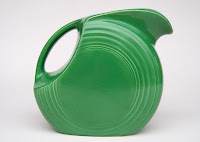Roses are red, violets are blue. I love gardening, do you?
As much as I love actually gardening, I love garden planning almost as much. It is a gardener's winter therapy. The new plant and seed catalogs are piling up on my desk, full of picture-perfect flowers and bright promises of warmer months ahead. (Okay, so it's really just daydreaming and doodling, but it's with a purpose.)
I especially love planning when I have a blank slate to work with, like I do now. First up on my to-do list is to create a potager-style vegetable garden with raised beds.
And my heart's desire: a long sweeping border full of flowers for cutting.
It would be easy to dive into a planting frenzy - so many plants provide gorgeous bouquets.
But instead of buying and planting willy-nilly, I have a method for designing these beds that will look thoughtfully landscaped, but not formal or boring, offering an evolving sequence of blooms from spring to fall. It's cottage gardening with some self-control. If you follow this method, you'll never wind up with a tall plant squatting in front of a delicate, diminutive one, or loud heavy orange blooms squeezing up against a froth of lacy pale pink petals. Unless you want to, of course.
Step 1: Determine the size of your bed (it can have curves, but this scheme works best with oblong or rectangle beds. Planting schemes can be adapted for island beds in round, kidney or square shapes - we'll talk about those in a future post.)
Step 2: Plot the bed on a rough grid of 12-inch or 18-inch squares (curves and bends are easily accommodated: you can drop a plant out, squish it in closer, or ease it to the left or right instead of being perfectly gridlocked.) Big grids or little grids? Personally, I plan - and plant - on a 12-15 inch grid for a fuller look. But I have been known to regret it when a plant sprawls larger than I anticipated. Huge plants and shrubs can be given a double or quadruple spot on the grid.
The top/back row is plotted (left-right): Tall/Early, Tall/Mid, Tall/Late, Tall/Early, Tall/Mid, Tall/Late...repeating as many times as needed.
The middle row is plotted as Medium/Late, Medium/Early, Medium/Mid, Medium/Late, Medium/Early, Medium/Mid....
And the front/bottom row is plotted as Short/Mid, Short/Late, Short/Early, Short/Mid, Short/Late, Short/Early...
Step 3: Choose your plants. Depending on the size of your space and your sensibilities, you can choose one, two or three different plants for each height and bloom season. (Fewer choices will give you more repetition and a more formal, polished look. Choosing more varieties will give you a fuller, freer look. However, if you go with more than three different plants for each height and bloom period, try to make sure each plant is included at least 3 times and choose plants that are similar in color and/or texture to provide visual continuity.)
Below is what my planting scheme looks like for each season (each block of color represents a specific plant's bloom color; the green blocks are the foliage on adjacent plants when they are not in bloom at that time.) Each of these plans represents an area 3 feet by 12 feet - I'll just keep repeating it down the fence row, stretching approximately 16 feet on each side of a wide gate. I'm using two plants per height and bloom season; 18 different plants will be repeated every 6 feet.
See how the flower colors start demure and pastel in spring and become more vibrant in summer and blazing hot colors in the fall? It's almost impossible to find screaming orange blooms in early spring (except tulips), or muted pastels in the fall, and I think it's easier and more natural looking for your colors to to work with Mother Nature than trying to fight her.
 |
| E=early/spring flowers |
 |
| M=mid/summer flowers |
 |
| L=late/fall flowers |
By staggering your plants by their peak bloom times, you don't wind up with a bunch of competing (or clashing) blooms lined up in front of one another. Instead, each season builds to a peak, then gradually gives way to the next. By designating each plant as tall (I classify anything over 4 feet as tall), medium (2-3 feet) and short (under 2 feet), you ensure that the tall ones are always in the back.
What about the advice of planting your perennials in groups of 3s or 5s and creating big swaths of color for impact? The ugly truth is those swaths tend to turn into huge voids when the bloom season ends. By repeating the plants every second or third spot, you get rhythm and continuity without "busy-ness" and the entire bed looks fresh and full of blooms from spring to frost.
If you like this idea, you're welcome to borrow it and apply your plants to it; please send pictures and bragging tales of your success stories!
If you are interested in having a planting scheme and nursery shopping list created for you, please contact me. I create custom plans based on your climate, sun and shade environment as well as your personal plant preferences, for a small fee. The plans include a planting chart and specific plant recommendations, plus mail order sources for varieties that may not be available in your area.
It's way too soon to get planting, but now is the time to get planning, especially if you are ordering any plants for spring delivery.
Happy gardening,
.










 Housework.
Housework.




















